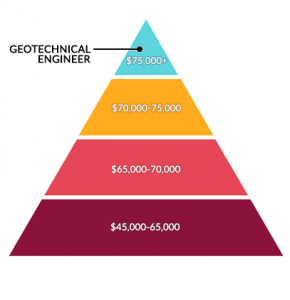A Biased View of Geotheta
A Biased View of Geotheta
Blog Article
Rumored Buzz on Geotheta
Table of ContentsThe smart Trick of Geotheta That Nobody is Discussing10 Easy Facts About Geotheta DescribedGeotheta Fundamentals ExplainedGeotheta Can Be Fun For EveryoneGeotheta for Dummies

They carry out site examinations, gather examples, execute laboratory examinations, and assess information to review the suitability of the ground for building and construction tasks - Tailings Engineer. Based upon their searchings for, geotechnical designers supply suggestions for foundation layout, slope stability, preserving structures, and mitigation of geotechnical hazards. They work together with other experts, such as architects, architectural designers, and building teams, to make sure that geotechnical factors to consider are incorporated right into the total task style and application
By examining the actions and homes of soil and rock, they can determine possible geotechnical risks such as landslides, soil settlement, or incline instability. Their know-how helps stop failures or mishaps that might threaten lives and property. Below are some thorough duties and responsibilities of a geotechnical designer: Website Examination: Geotechnical designers conduct website investigations to gather data on subsurface conditions.
They analyze the data to understand the homes and actions of the soil and rock, including their stamina, permeability, compaction attributes, and groundwater problems. Geotechnical Evaluation and Layout: Geotechnical designers assess the data accumulated throughout website investigations to evaluate the stability and viability of the site for building jobs. They do geotechnical computations and modeling to examine variables such as bearing ability, settlement, incline stability, lateral planet pressures, and groundwater flow.
The Ultimate Guide To Geotheta
Structure Design: Geotechnical engineers play a vital duty in designing foundations that can safely support the desired structure. They assess the soil problems and tons requirements to figure out the proper structure type, such as shallow foundations (e.g., grounds), deep foundations (e.g (https://www.storeboard.com/geotheta)., heaps), or specialized methods like dirt renovation. They consider aspects such as settlement limits, birthing ability, and soil-structure interaction to create optimal foundation designs
They evaluate building strategies, monitor website tasks, and perform field evaluations to confirm that the layout referrals are adhered to. If unexpected geotechnical concerns arise, they examine the situation and give referrals for removal or adjustments to the layout. Danger Evaluation and Reduction: Geotechnical designers assess geotechnical dangers and threats connected with the job site, such as landslides, liquefaction, or soil disintegration.

Collaboration and Interaction: Geotechnical designers work carefully with various other professionals associated with a task, such as engineers, structural engineers, and building groups. Reliable interaction and collaboration are important to incorporate geotechnical considerations right into the overall task style and construction process. Geotechnical engineers offer technological know-how, answer inquiries, and ensure that geotechnical needs are fulfilled.
The Ultimate Guide To Geotheta
Right here are some kinds of geotechnical engineers: Foundation Designer: Foundation engineers focus on creating and evaluating structures for structures. They assess the soil conditions, load demands, and website attributes to establish the most proper structure kind and style, such as shallow foundations, deep structures, or specialized methods like heap foundations.
They assess the elements affecting slope security, such as dirt properties, groundwater conditions, and incline geometry, and develop methods to avoid slope failures and mitigate risks. Earthquake Designer: Quake designers concentrate on analyzing and developing structures to endure seismic pressures. They assess the seismic risk of a site, evaluate soil liquefaction capacity, and create seismic layout standards to make sure the safety and security and strength of structures throughout quakes.
They do field testing, accumulate examples, and examine the gathered data to identify the soil properties, geologic formations, and groundwater conditions at a site. Geotechnical Instrumentation Engineer: Geotechnical instrumentation designers concentrate on surveillance and determining the habits of dirt, rock, and structures. They mount and preserve instrumentation systems that keep an eye on factors such as dirt settlement, groundwater degrees, slope activities, and structural variations to evaluate efficiency and offer early cautions of potential concerns.
About Geotheta
They perform tests such as triaxial examinations, consolidation tests, direct shear tests, and permeability tests to gather data for geotechnical evaluation and style. Geosynthetics Designer: Geosynthetics engineers focus on the style and application of geosynthetic materials, such as geotextiles, geogrids, and geomembranes. They utilize these products to enhance soil stability, reinforce slopes, provide water drainage services, and control erosion.
They tend to be investigatory individuals, which indicates they're intellectual, introspective, and curious. They are curious, systematic, logical, logical, and logical. Some of them are also social, meaning they're kind, charitable, cooperative, client, caring, useful, compassionate, tactful, and pleasant - Tailings Engineer.
In the workplace environment, geotechnical designers use specialized software tools to carry out computations, create designs, and assess information. They click for more prepare reports, testimonial task specs, connect with customers and staff member, and coordinate project activities. The office setup provides a conducive setting for research, analysis, and partnership with various other professionals included in the job.
The smart Trick of Geotheta That Nobody is Discussing
They frequently check out project sites to perform website examinations, evaluate geotechnical problems, and gather information for evaluation. These check outs involve taking a trip to different places, sometimes in remote or tough terrains. Geotechnical designers may perform dirt sampling, conduct tests, and screen building and construction tasks to guarantee that the geotechnical aspects of the task are being implemented correctly.
Geotechnical engineers additionally function in specialized geotechnical research laboratories. Geotechnical lab designers work thoroughly in these settings, handling testing devices, operating instruments, and tape-recording information.
Report this page